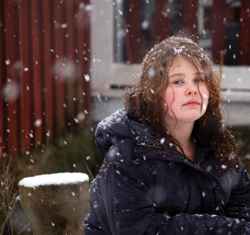
If you suffer from these wintertime blues, you are not alone. It is estimated that there are over 34 million SAD sufferers in America today, and of those who suffer from it, women outnumber men four to one. Research tends to imply that two percent of our population suffers with severe SAD and about 10 percent suffer from moderate to mild symptoms of the disorder. Across the world, incidences increase with greater distance from the equator.
Not all sufferers have identical symptoms, however. All sufferers report mild to severe depression, but some note excessive eating and weight gain as well. Some report an increase in the craving of carbohydrates in their diets, while others describe fatigue, which tends to be worse in the afternoon. Some sufferers note feeling hopeless and sad, while others report an increase in crying or excessive sleeping and napping.
There are those who doubt the seriousness of Seasonal Affective Disorder, believing it to be a new catchphrase for those who are lazy or inactive during the winter months. However, researcher Dr. Alfred Lewy first discovered depressive symptoms during the fall and winter in 1845. His discoveries were brought to light (sorry for the pun), in the mid-1980s, when it was discovered that bright light released melatonin in the body, relieving the symptoms of depression. Typically, depression or the winter blues is lowered when bright light enters the eyes.
It is helpful to decide if you are feeling down because of Seasonal Affective Disorder or if there are other reasons for your depression. The cyclical nature of SAD is its easiest identifier. Do you usually feel happier and more upbeat in the summer? Do you start feeling gloomy as fall arrives, dreading the coming winter? Does your energy level drop significantly as the thermometer falls? Finally, does your weight go up regularly every winter, only to then drop in the spring and summer? If you answer yes to these questions, there is a very good chance that you have SAD.
There are some simple techniques which can minimize the symptoms of Seasonal Affective Disorder:
- Direct sunlight. The first suggestion for treatment is absolutely free! One of the simplest solutions is to incorporate more time outdoors during daylight hours. Rain or shine, try to gain exposure to the sun for at least 30 to 45 minutes every day, even if the sunlight is filtered or indirect.
- Light treatments. Light boxes or full spectrum bulbs are commonly available at many stores and from healthy-living catalogs. The light bulbs are less expensive than light boxes (which generally cost $300), but are not as effective. However, they do offer a low-cost option of light exposure treatment. Research indicates a 70 percent success rate for light therapy, with the highest response from those who utilize a light box versus light bulbs. Typically, sufferers sit in front of the light box or bulb for 30 to 45 minutes each day and require 2500 lux exposure.
- Water. Research indicates that increasing water intake will lower the effects of Seasonal Affective Disorder. Try to drink eight to 10 glasses of water every day (and no—you won’t float away!).
- Exercise. Establish a daily exercise program and try to work out in the mornings or early afternoon. Late-night exercise tends to affect sleeping patterns and encourage sleeplessness.
- Diet. Research suggests an increase in complex carbohydrates such as pasta, potatoes and bread. These foods tend to aid in the production of serotonin and decrease the symptoms of depression.
- Medication. Today, there are numerous medications which are extremely effective in minimizing the effects of Seasonal Affective Disorder.
- Counseling. Therapy can be extremely effective in combination with these other techniques. Counseling is beneficial in learning to deal with depressive symptoms and learning ways to change thought patterns and behaviors which add to the burden of depression.
Hopefully these suggestions will be helpful to those of you who suffer from SAD. I’ve always thought it might be helpful for the City of Peoria to purchase a giant spotlight that could be shown on our city during the day. Surely the bright light would decrease many sufferers’ symptoms and relieve those winter blues. Perhaps I’ll call the mayor and see what he has to say about this idea. But in the meantime, maybe I should just go outside for a while and take my dog for a walk in the sunlight! TPW
Dr. Miller is the founder and director of Peoria’s Joy Miller & Associates. She is an internationally-known licensed psychotherapist, professional trainer and author. A part-time instructor at Bradley University, she has been professionally involved in the mental health field for 25 years. For more information on mental health visit www.joymillerblog.blogspot.com.
